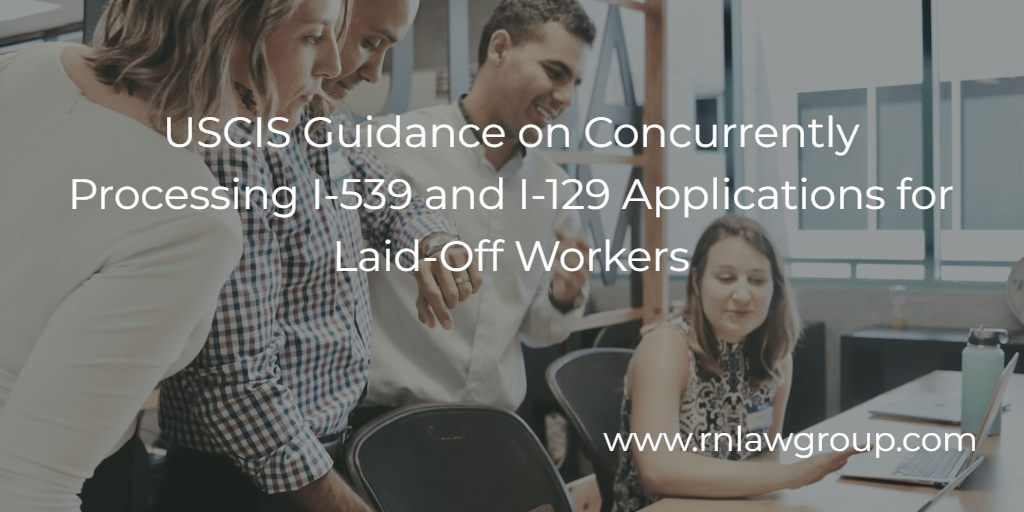
USCIS Guidance on Concurrently Processing I-539 and I-129 Applications for Laid-Off Workers
As part of its resources addressing the recent layoffs affecting many nonimmigrant workers, USCIS has recently clarified its position on the processing of an I-539 change of status application and an I-129 petition filed for the same individual.
The Scenario
An example of this scenario is as follows:
- Worker in H-1B (or L-1, TN, E, or O) status is laid off while their I-94 is still valid.
- The worker has a 60-day grace period from their last date of employment, during which a new application or petition may be filed on their behalf and be considered timely, or during which they may depart the U.S.
- The worker’s first choice is to find new employment, and have a change of employer (transfer) petition filed on their behalf by the new company within the 60-day grace period.
- If this is not possible within the 60-day grace period, the worker decides to file an I-539 application before the 60-day deadline to change their status to H-4 (if their spouse is in H-1B status) or B-1/B-2 (if they remain in the U.S. to make arrangements before departure, or to continue job searching).
- While the I-539 application is pending, but after the grace period has elapsed, the applicant receives a job offer from a company willing to file the H-1B petition on their behalf.
- The new company files an I-129 petition requesting to change the applicant’s status back to H-1B, in premium processing.
In this situation, at the time the I-129 petition is filed, the applicant is in a “period of authorized stay” based on the pending I-539 application; they are no longer in H-1B status because the grace period has expired, but they are not yet in H-4 or B-1/B-2 status because the I-539 application has not been approved yet. Because the I-539 application was timely filed during the grace period, the applicant is authorized to remain in the U.S., but cannot work.
USCIS’s Prior Policy
Previously, USCIS’s practice in this scenario was to delay adjudication of the I-129 petition until the I-539 application had been decided. This was because the I-129 change of status being approved depended on the applicant being in status at the time the I-129 petition was filed, and USCIS did not know whether the applicant was in status at that time, until the I-539 application had been decided. If the I-539 application was approved, the applicant was considered in status dating back to its filing, and the I-129 petition could be approved. Likewise, if the I-539 application was denied for some reason, USCIS would deny the I-129 change of status request.
The problem with this policy was the lengthy processing time for I-539 applications, which do not have a premium processing option and can often take 6-12 months to adjudicate. Even if the I-129 petition was filed in premium processing, if the I-539 was still pending during the I-129’s 15-day processing window, USCIS would issue a Request for Evidence asking for the I-539 approval notice to be submitted, when available. Applicants would need to hope that the I-539 would be approved within the 90-day RFE response deadline, at which time the I-539 approval notice would be submitted in order for the I-129 change of status to be approved. During these 6-12 months, the applicant would not be authorized to work for the new employer, despite the pending I-129 petition.
The above processing difficulty resulted in most I-129 petitions being filed requesting consular processing, as the change of status could take several months. If the applicant had a valid visa stamp in the H-1B category, the I-129 petition could be approved within 2 weeks in premium processing (without the I-94), and the applicant would need to make a short trip out of the U.S. and re-enter with the new approval notice in order to return to H-1B status and be authorized to start work. If the applicant did not have a valid visa stamp, the consular processing route would require a visit to a consulate to obtain a new visa stamp, which could also be a lengthy wait time, but still potentially faster than waiting for the I-539 to be approved.
USCIS’s New Guidance
Under its new guidance, detailed recently on USCIS’s Twitter page, the agency will strive to adjudicate the pending I-539 application and the I-129 petition simultaneously. If approved, the applicant would receive an H-1B approval notice with the I-94 attachment, enabling them to start work upon the petition’s approval without the need to exit the U.S. or wait several months for the I-539 to be separately adjudicated. This policy will greatly help workers who find themselves needing to file an I-539 application due to a layoff, as well as the new employers who will be able to onboard their new hire in a timely manner.
This practice of concurrently processing an applicant’s I-539 and I-129 petition simultaneously had been observed in limited situations in recent years, but was not officially stated by USCIS until its recent clarification. While USCIS’s answer on Twitter was in response to a question about a pending I-539 for B-1/B-2 status, the same practice should apply to I-539s requesting other visa classifications, such as H-4 or L-2. USCIS’s guidance also states that no formal request is required for the pending I-539 to receive this prioritized processing, although applicants should ensure that the I-129 petition includes a copy of their I-539 receipt notice so that USCIS is aware of the pending application.
We are committed to assisting our clients with navigating the often complicated employment-based visa process and other challenging immigration matters as an accomplished business immigration law firm in Houston, Texas. Feel free to contact us or set up a consultation to discuss your specific options in the event your employment is terminated or needs to be transferred.
By: Rebecca Chen
Rebecca Chen is a Partner at Reddy & Neumann. Her representation includes advising clients throughout the non-immigrant and immigrant visa application process, from initial filing, responding to various requests for evidence, and processing at overseas consulates. Her years of experience in the immigration field have made her a knowledgeable resource for complex business immigration matters.

